ICTSUS601: Integrating Sustainability in ICT Planning and Design
VerifiedAdded on 2023/06/12
|17
|6401
|451
Report
AI Summary
This report addresses the integration of sustainability into ICT planning and design projects, focusing on best practices, legal compliance, and practical implementation. It covers approaches to ensure sustainability, the purpose and scope of the Environment Protection and Biodiversity Conservation Act 1999 (EPBC Act), and the AS/NZS 3598:2014 standards. The report also discusses Work Health & Safety (WHS) implications, CO2 emission estimations, policy development processes, and methods to address resistance to new policies. Furthermore, it details power consumption audits, tools for sustainability improvements, Quality Management Plans, payback periods for ICT projects, and sustainability criteria for the workplace. The report reviews ICT systems for sustainability integration, recommends short-term technology options for power reduction, and prioritizes ICT projects fostering sustainability. It also outlines procedures for ICT equipment disposal and sustainable procurement practices.
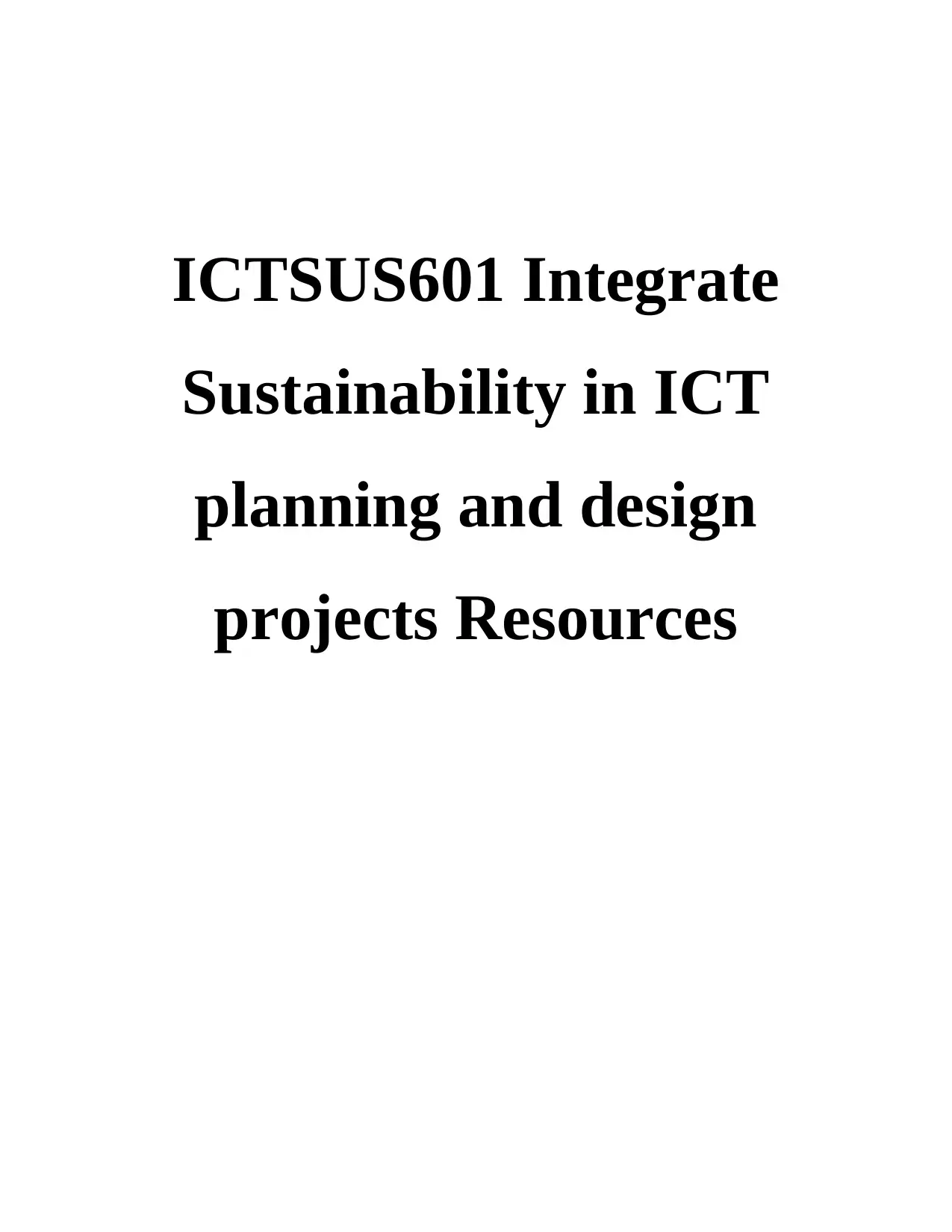
ICTSUS601 Integrate
Sustainability in ICT
planning and design
projects Resources
Sustainability in ICT
planning and design
projects Resources
Paraphrase This Document
Need a fresh take? Get an instant paraphrase of this document with our AI Paraphraser
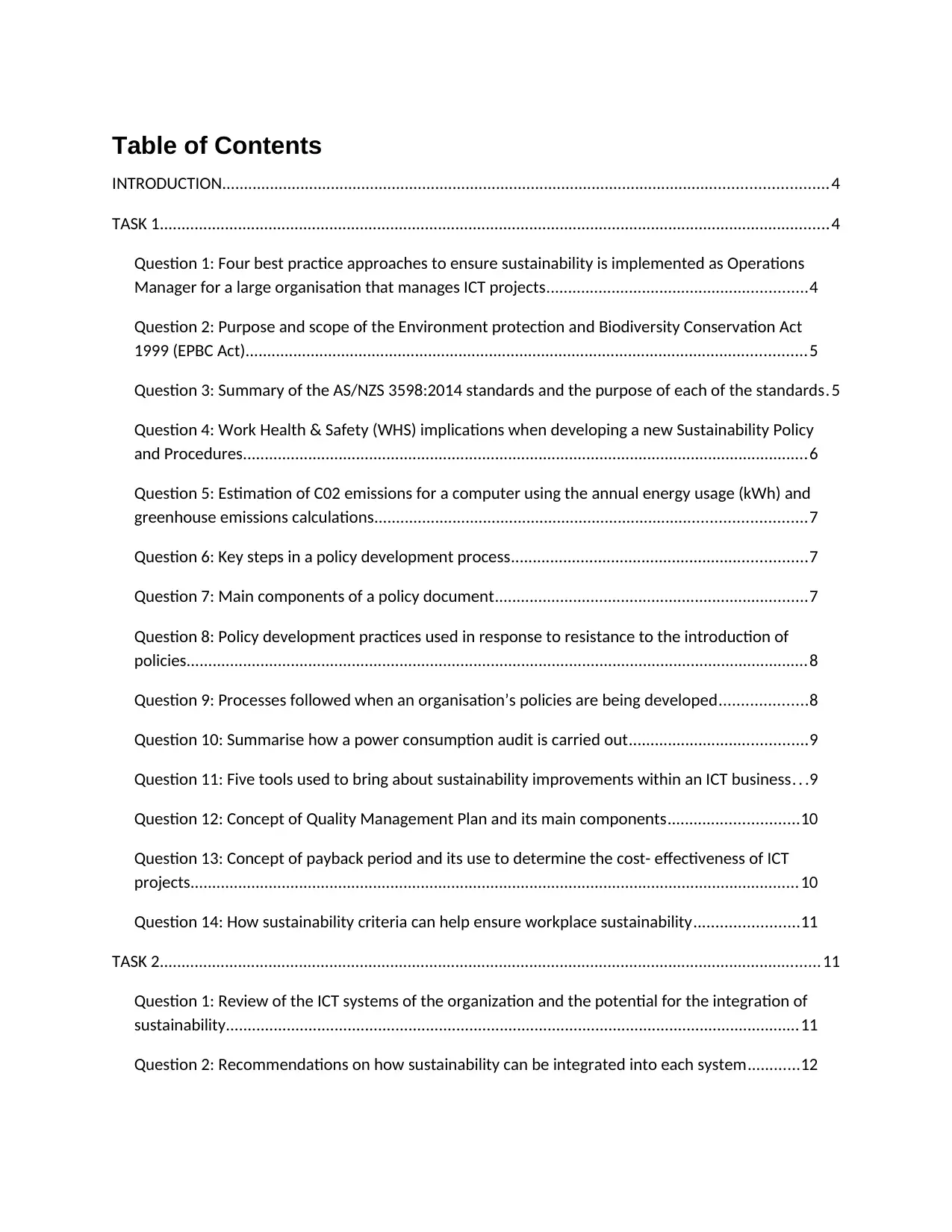
Table of Contents
INTRODUCTION...........................................................................................................................................4
TASK 1..........................................................................................................................................................4
Question 1: Four best practice approaches to ensure sustainability is implemented as Operations
Manager for a large organisation that manages ICT projects............................................................4
Question 2: Purpose and scope of the Environment protection and Biodiversity Conservation Act
1999 (EPBC Act).................................................................................................................................5
Question 3: Summary of the AS/NZS 3598:2014 standards and the purpose of each of the standards.5
Question 4: Work Health & Safety (WHS) implications when developing a new Sustainability Policy
and Procedures..................................................................................................................................6
Question 5: Estimation of C02 emissions for a computer using the annual energy usage (kWh) and
greenhouse emissions calculations...................................................................................................7
Question 6: Key steps in a policy development process....................................................................7
Question 7: Main components of a policy document........................................................................7
Question 8: Policy development practices used in response to resistance to the introduction of
policies...............................................................................................................................................8
Question 9: Processes followed when an organisation’s policies are being developed....................8
Question 10: Summarise how a power consumption audit is carried out.........................................9
Question 11: Five tools used to bring about sustainability improvements within an ICT business. . .9
Question 12: Concept of Quality Management Plan and its main components..............................10
Question 13: Concept of payback period and its use to determine the cost- effectiveness of ICT
projects............................................................................................................................................10
Question 14: How sustainability criteria can help ensure workplace sustainability........................11
TASK 2........................................................................................................................................................11
Question 1: Review of the ICT systems of the organization and the potential for the integration of
sustainability....................................................................................................................................11
Question 2: Recommendations on how sustainability can be integrated into each system............12
INTRODUCTION...........................................................................................................................................4
TASK 1..........................................................................................................................................................4
Question 1: Four best practice approaches to ensure sustainability is implemented as Operations
Manager for a large organisation that manages ICT projects............................................................4
Question 2: Purpose and scope of the Environment protection and Biodiversity Conservation Act
1999 (EPBC Act).................................................................................................................................5
Question 3: Summary of the AS/NZS 3598:2014 standards and the purpose of each of the standards.5
Question 4: Work Health & Safety (WHS) implications when developing a new Sustainability Policy
and Procedures..................................................................................................................................6
Question 5: Estimation of C02 emissions for a computer using the annual energy usage (kWh) and
greenhouse emissions calculations...................................................................................................7
Question 6: Key steps in a policy development process....................................................................7
Question 7: Main components of a policy document........................................................................7
Question 8: Policy development practices used in response to resistance to the introduction of
policies...............................................................................................................................................8
Question 9: Processes followed when an organisation’s policies are being developed....................8
Question 10: Summarise how a power consumption audit is carried out.........................................9
Question 11: Five tools used to bring about sustainability improvements within an ICT business. . .9
Question 12: Concept of Quality Management Plan and its main components..............................10
Question 13: Concept of payback period and its use to determine the cost- effectiveness of ICT
projects............................................................................................................................................10
Question 14: How sustainability criteria can help ensure workplace sustainability........................11
TASK 2........................................................................................................................................................11
Question 1: Review of the ICT systems of the organization and the potential for the integration of
sustainability....................................................................................................................................11
Question 2: Recommendations on how sustainability can be integrated into each system............12
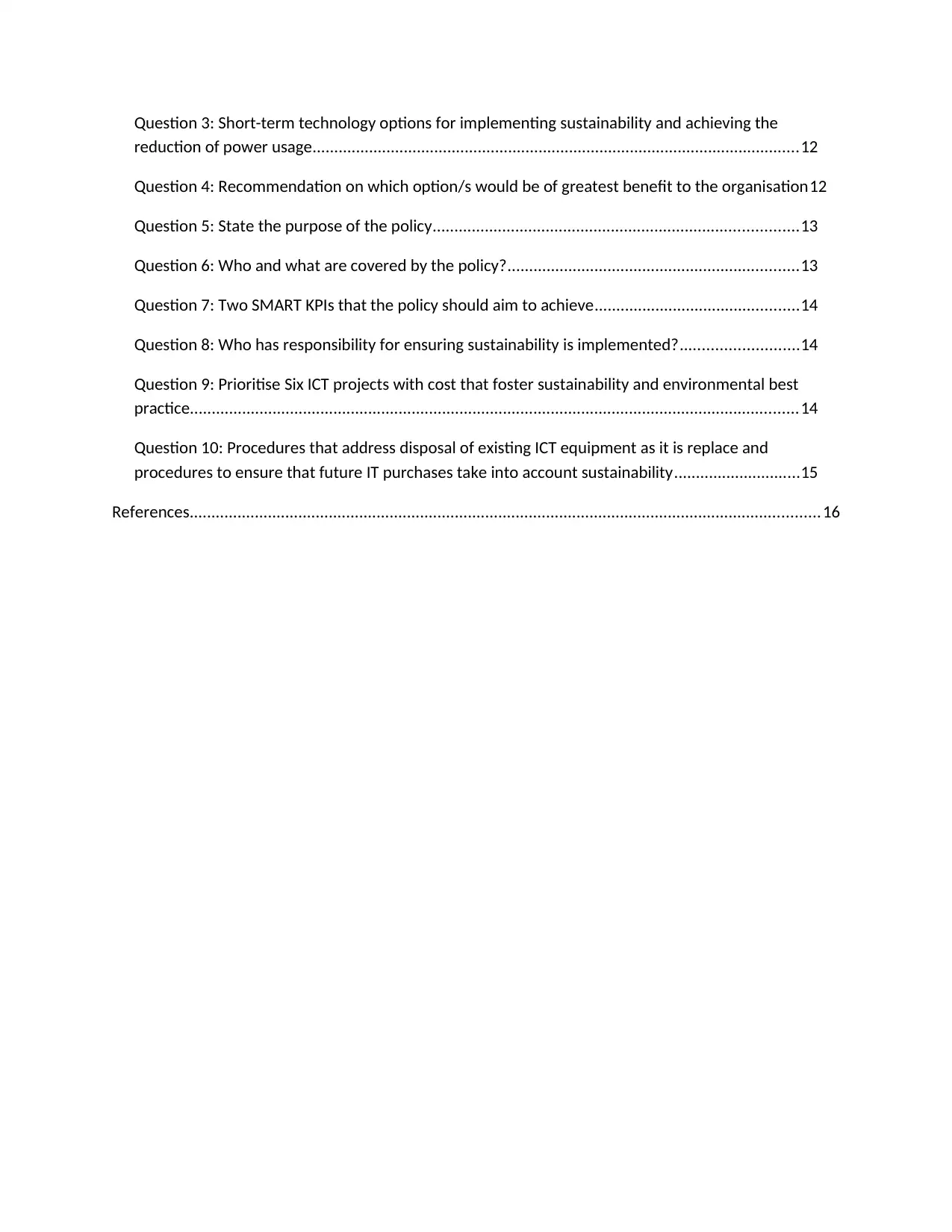
Question 3: Short-term technology options for implementing sustainability and achieving the
reduction of power usage................................................................................................................12
Question 4: Recommendation on which option/s would be of greatest benefit to the organisation12
Question 5: State the purpose of the policy....................................................................................13
Question 6: Who and what are covered by the policy?...................................................................13
Question 7: Two SMART KPIs that the policy should aim to achieve...............................................14
Question 8: Who has responsibility for ensuring sustainability is implemented?...........................14
Question 9: Prioritise Six ICT projects with cost that foster sustainability and environmental best
practice............................................................................................................................................14
Question 10: Procedures that address disposal of existing ICT equipment as it is replace and
procedures to ensure that future IT purchases take into account sustainability.............................15
References.................................................................................................................................................16
reduction of power usage................................................................................................................12
Question 4: Recommendation on which option/s would be of greatest benefit to the organisation12
Question 5: State the purpose of the policy....................................................................................13
Question 6: Who and what are covered by the policy?...................................................................13
Question 7: Two SMART KPIs that the policy should aim to achieve...............................................14
Question 8: Who has responsibility for ensuring sustainability is implemented?...........................14
Question 9: Prioritise Six ICT projects with cost that foster sustainability and environmental best
practice............................................................................................................................................14
Question 10: Procedures that address disposal of existing ICT equipment as it is replace and
procedures to ensure that future IT purchases take into account sustainability.............................15
References.................................................................................................................................................16
⊘ This is a preview!⊘
Do you want full access?
Subscribe today to unlock all pages.

Trusted by 1+ million students worldwide
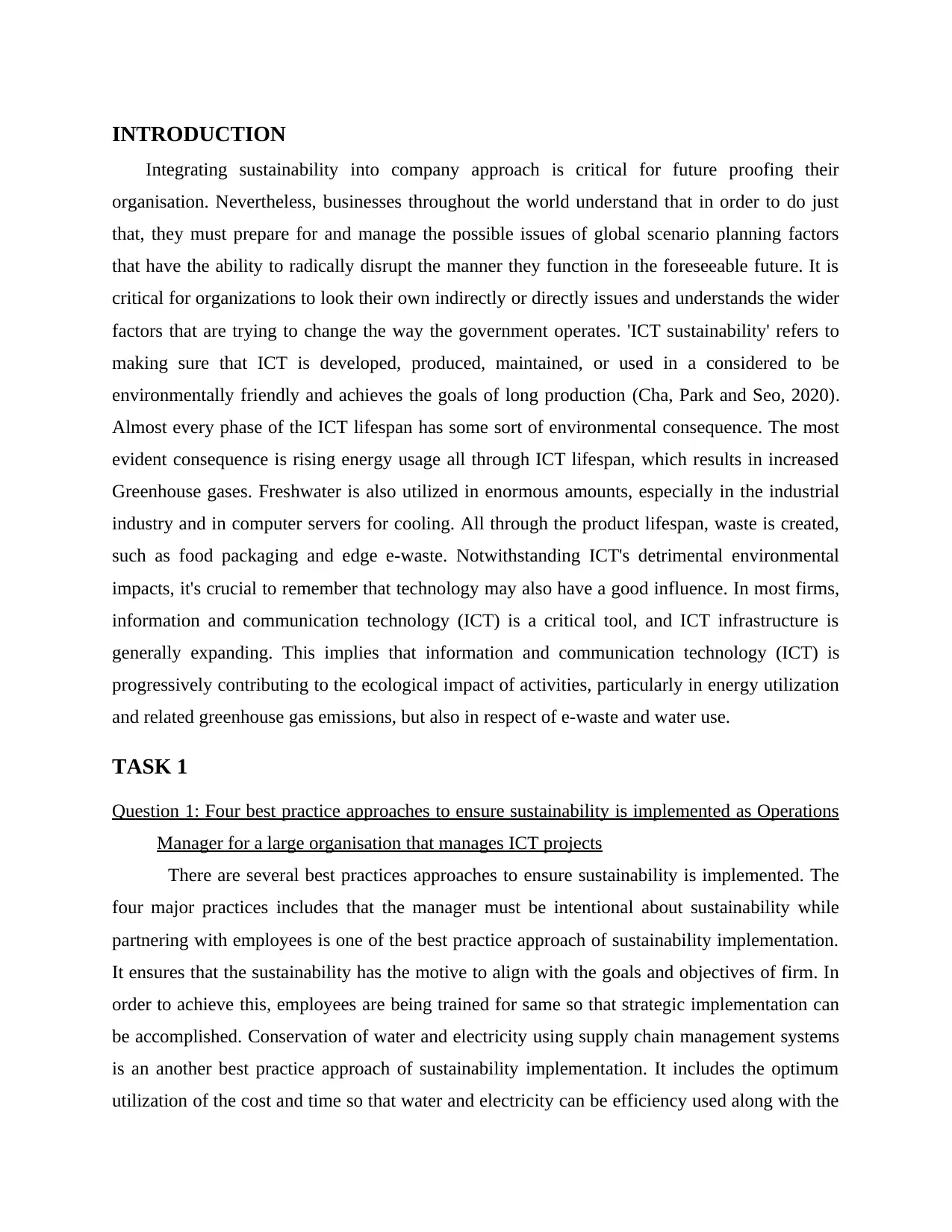
INTRODUCTION
Integrating sustainability into company approach is critical for future proofing their
organisation. Nevertheless, businesses throughout the world understand that in order to do just
that, they must prepare for and manage the possible issues of global scenario planning factors
that have the ability to radically disrupt the manner they function in the foreseeable future. It is
critical for organizations to look their own indirectly or directly issues and understands the wider
factors that are trying to change the way the government operates. 'ICT sustainability' refers to
making sure that ICT is developed, produced, maintained, or used in a considered to be
environmentally friendly and achieves the goals of long production (Cha, Park and Seo, 2020).
Almost every phase of the ICT lifespan has some sort of environmental consequence. The most
evident consequence is rising energy usage all through ICT lifespan, which results in increased
Greenhouse gases. Freshwater is also utilized in enormous amounts, especially in the industrial
industry and in computer servers for cooling. All through the product lifespan, waste is created,
such as food packaging and edge e-waste. Notwithstanding ICT's detrimental environmental
impacts, it's crucial to remember that technology may also have a good influence. In most firms,
information and communication technology (ICT) is a critical tool, and ICT infrastructure is
generally expanding. This implies that information and communication technology (ICT) is
progressively contributing to the ecological impact of activities, particularly in energy utilization
and related greenhouse gas emissions, but also in respect of e-waste and water use.
TASK 1
Question 1: Four best practice approaches to ensure sustainability is implemented as Operations
Manager for a large organisation that manages ICT projects
There are several best practices approaches to ensure sustainability is implemented. The
four major practices includes that the manager must be intentional about sustainability while
partnering with employees is one of the best practice approach of sustainability implementation.
It ensures that the sustainability has the motive to align with the goals and objectives of firm. In
order to achieve this, employees are being trained for same so that strategic implementation can
be accomplished. Conservation of water and electricity using supply chain management systems
is an another best practice approach of sustainability implementation. It includes the optimum
utilization of the cost and time so that water and electricity can be efficiency used along with the
Integrating sustainability into company approach is critical for future proofing their
organisation. Nevertheless, businesses throughout the world understand that in order to do just
that, they must prepare for and manage the possible issues of global scenario planning factors
that have the ability to radically disrupt the manner they function in the foreseeable future. It is
critical for organizations to look their own indirectly or directly issues and understands the wider
factors that are trying to change the way the government operates. 'ICT sustainability' refers to
making sure that ICT is developed, produced, maintained, or used in a considered to be
environmentally friendly and achieves the goals of long production (Cha, Park and Seo, 2020).
Almost every phase of the ICT lifespan has some sort of environmental consequence. The most
evident consequence is rising energy usage all through ICT lifespan, which results in increased
Greenhouse gases. Freshwater is also utilized in enormous amounts, especially in the industrial
industry and in computer servers for cooling. All through the product lifespan, waste is created,
such as food packaging and edge e-waste. Notwithstanding ICT's detrimental environmental
impacts, it's crucial to remember that technology may also have a good influence. In most firms,
information and communication technology (ICT) is a critical tool, and ICT infrastructure is
generally expanding. This implies that information and communication technology (ICT) is
progressively contributing to the ecological impact of activities, particularly in energy utilization
and related greenhouse gas emissions, but also in respect of e-waste and water use.
TASK 1
Question 1: Four best practice approaches to ensure sustainability is implemented as Operations
Manager for a large organisation that manages ICT projects
There are several best practices approaches to ensure sustainability is implemented. The
four major practices includes that the manager must be intentional about sustainability while
partnering with employees is one of the best practice approach of sustainability implementation.
It ensures that the sustainability has the motive to align with the goals and objectives of firm. In
order to achieve this, employees are being trained for same so that strategic implementation can
be accomplished. Conservation of water and electricity using supply chain management systems
is an another best practice approach of sustainability implementation. It includes the optimum
utilization of the cost and time so that water and electricity can be efficiency used along with the
Paraphrase This Document
Need a fresh take? Get an instant paraphrase of this document with our AI Paraphraser
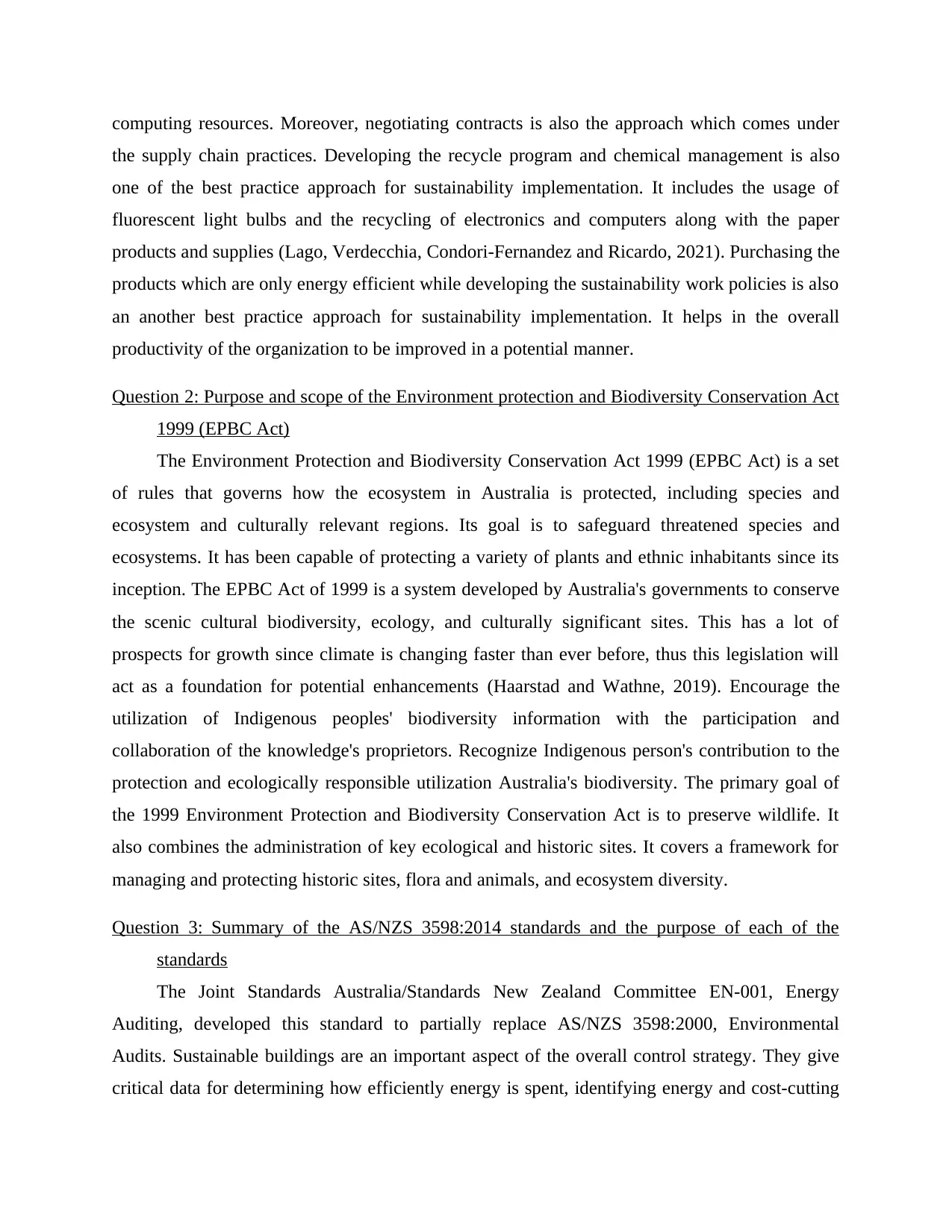
computing resources. Moreover, negotiating contracts is also the approach which comes under
the supply chain practices. Developing the recycle program and chemical management is also
one of the best practice approach for sustainability implementation. It includes the usage of
fluorescent light bulbs and the recycling of electronics and computers along with the paper
products and supplies (Lago, Verdecchia, Condori-Fernandez and Ricardo, 2021). Purchasing the
products which are only energy efficient while developing the sustainability work policies is also
an another best practice approach for sustainability implementation. It helps in the overall
productivity of the organization to be improved in a potential manner.
Question 2: Purpose and scope of the Environment protection and Biodiversity Conservation Act
1999 (EPBC Act)
The Environment Protection and Biodiversity Conservation Act 1999 (EPBC Act) is a set
of rules that governs how the ecosystem in Australia is protected, including species and
ecosystem and culturally relevant regions. Its goal is to safeguard threatened species and
ecosystems. It has been capable of protecting a variety of plants and ethnic inhabitants since its
inception. The EPBC Act of 1999 is a system developed by Australia's governments to conserve
the scenic cultural biodiversity, ecology, and culturally significant sites. This has a lot of
prospects for growth since climate is changing faster than ever before, thus this legislation will
act as a foundation for potential enhancements (Haarstad and Wathne, 2019). Encourage the
utilization of Indigenous peoples' biodiversity information with the participation and
collaboration of the knowledge's proprietors. Recognize Indigenous person's contribution to the
protection and ecologically responsible utilization Australia's biodiversity. The primary goal of
the 1999 Environment Protection and Biodiversity Conservation Act is to preserve wildlife. It
also combines the administration of key ecological and historic sites. It covers a framework for
managing and protecting historic sites, flora and animals, and ecosystem diversity.
Question 3: Summary of the AS/NZS 3598:2014 standards and the purpose of each of the
standards
The Joint Standards Australia/Standards New Zealand Committee EN-001, Energy
Auditing, developed this standard to partially replace AS/NZS 3598:2000, Environmental
Audits. Sustainable buildings are an important aspect of the overall control strategy. They give
critical data for determining how efficiently energy is spent, identifying energy and cost-cutting
the supply chain practices. Developing the recycle program and chemical management is also
one of the best practice approach for sustainability implementation. It includes the usage of
fluorescent light bulbs and the recycling of electronics and computers along with the paper
products and supplies (Lago, Verdecchia, Condori-Fernandez and Ricardo, 2021). Purchasing the
products which are only energy efficient while developing the sustainability work policies is also
an another best practice approach for sustainability implementation. It helps in the overall
productivity of the organization to be improved in a potential manner.
Question 2: Purpose and scope of the Environment protection and Biodiversity Conservation Act
1999 (EPBC Act)
The Environment Protection and Biodiversity Conservation Act 1999 (EPBC Act) is a set
of rules that governs how the ecosystem in Australia is protected, including species and
ecosystem and culturally relevant regions. Its goal is to safeguard threatened species and
ecosystems. It has been capable of protecting a variety of plants and ethnic inhabitants since its
inception. The EPBC Act of 1999 is a system developed by Australia's governments to conserve
the scenic cultural biodiversity, ecology, and culturally significant sites. This has a lot of
prospects for growth since climate is changing faster than ever before, thus this legislation will
act as a foundation for potential enhancements (Haarstad and Wathne, 2019). Encourage the
utilization of Indigenous peoples' biodiversity information with the participation and
collaboration of the knowledge's proprietors. Recognize Indigenous person's contribution to the
protection and ecologically responsible utilization Australia's biodiversity. The primary goal of
the 1999 Environment Protection and Biodiversity Conservation Act is to preserve wildlife. It
also combines the administration of key ecological and historic sites. It covers a framework for
managing and protecting historic sites, flora and animals, and ecosystem diversity.
Question 3: Summary of the AS/NZS 3598:2014 standards and the purpose of each of the
standards
The Joint Standards Australia/Standards New Zealand Committee EN-001, Energy
Auditing, developed this standard to partially replace AS/NZS 3598:2000, Environmental
Audits. Sustainable buildings are an important aspect of the overall control strategy. They give
critical data for determining how efficiently energy is spent, identifying energy and cost-cutting
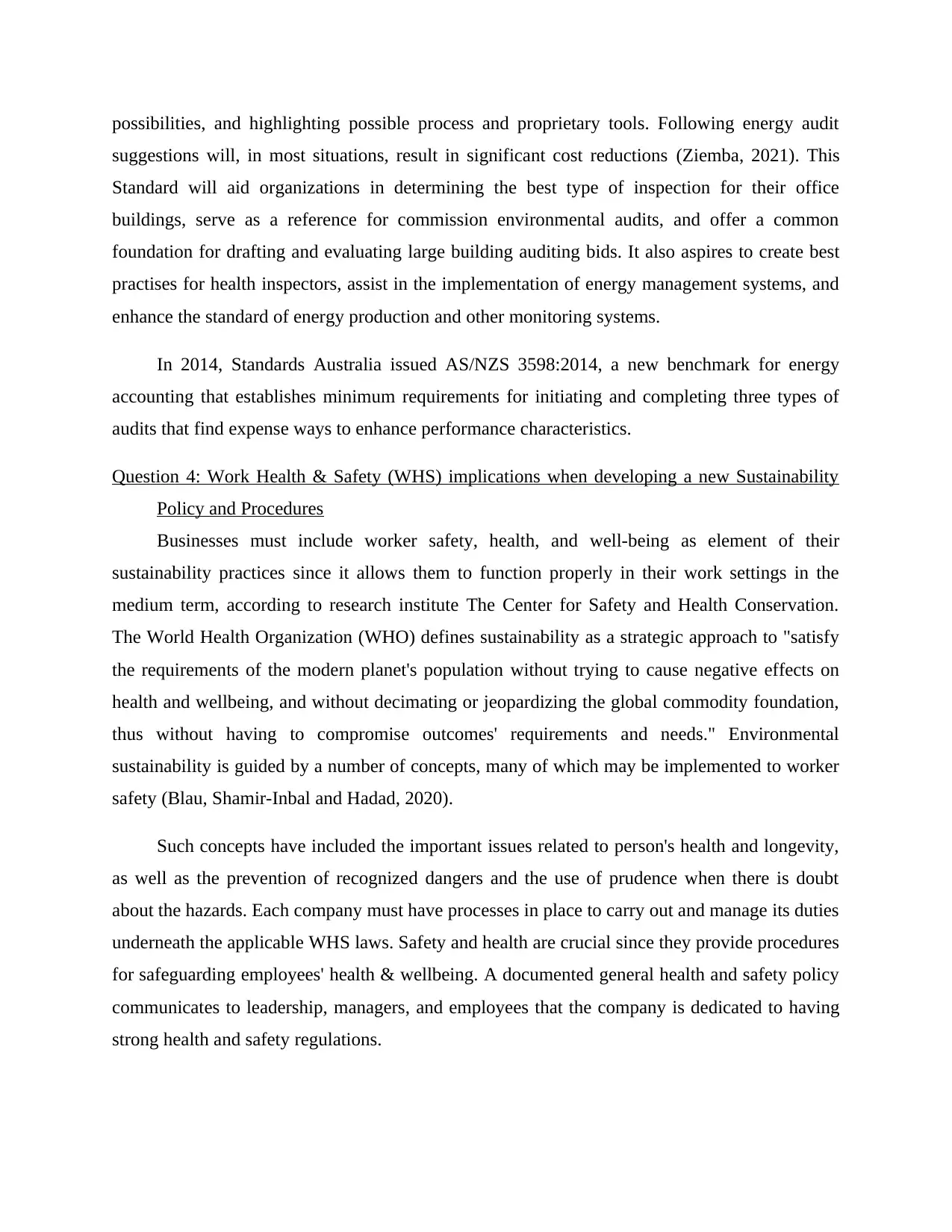
possibilities, and highlighting possible process and proprietary tools. Following energy audit
suggestions will, in most situations, result in significant cost reductions (Ziemba, 2021). This
Standard will aid organizations in determining the best type of inspection for their office
buildings, serve as a reference for commission environmental audits, and offer a common
foundation for drafting and evaluating large building auditing bids. It also aspires to create best
practises for health inspectors, assist in the implementation of energy management systems, and
enhance the standard of energy production and other monitoring systems.
In 2014, Standards Australia issued AS/NZS 3598:2014, a new benchmark for energy
accounting that establishes minimum requirements for initiating and completing three types of
audits that find expense ways to enhance performance characteristics.
Question 4: Work Health & Safety (WHS) implications when developing a new Sustainability
Policy and Procedures
Businesses must include worker safety, health, and well-being as element of their
sustainability practices since it allows them to function properly in their work settings in the
medium term, according to research institute The Center for Safety and Health Conservation.
The World Health Organization (WHO) defines sustainability as a strategic approach to "satisfy
the requirements of the modern planet's population without trying to cause negative effects on
health and wellbeing, and without decimating or jeopardizing the global commodity foundation,
thus without having to compromise outcomes' requirements and needs." Environmental
sustainability is guided by a number of concepts, many of which may be implemented to worker
safety (Blau, Shamir‐Inbal and Hadad, 2020).
Such concepts have included the important issues related to person's health and longevity,
as well as the prevention of recognized dangers and the use of prudence when there is doubt
about the hazards. Each company must have processes in place to carry out and manage its duties
underneath the applicable WHS laws. Safety and health are crucial since they provide procedures
for safeguarding employees' health & wellbeing. A documented general health and safety policy
communicates to leadership, managers, and employees that the company is dedicated to having
strong health and safety regulations.
suggestions will, in most situations, result in significant cost reductions (Ziemba, 2021). This
Standard will aid organizations in determining the best type of inspection for their office
buildings, serve as a reference for commission environmental audits, and offer a common
foundation for drafting and evaluating large building auditing bids. It also aspires to create best
practises for health inspectors, assist in the implementation of energy management systems, and
enhance the standard of energy production and other monitoring systems.
In 2014, Standards Australia issued AS/NZS 3598:2014, a new benchmark for energy
accounting that establishes minimum requirements for initiating and completing three types of
audits that find expense ways to enhance performance characteristics.
Question 4: Work Health & Safety (WHS) implications when developing a new Sustainability
Policy and Procedures
Businesses must include worker safety, health, and well-being as element of their
sustainability practices since it allows them to function properly in their work settings in the
medium term, according to research institute The Center for Safety and Health Conservation.
The World Health Organization (WHO) defines sustainability as a strategic approach to "satisfy
the requirements of the modern planet's population without trying to cause negative effects on
health and wellbeing, and without decimating or jeopardizing the global commodity foundation,
thus without having to compromise outcomes' requirements and needs." Environmental
sustainability is guided by a number of concepts, many of which may be implemented to worker
safety (Blau, Shamir‐Inbal and Hadad, 2020).
Such concepts have included the important issues related to person's health and longevity,
as well as the prevention of recognized dangers and the use of prudence when there is doubt
about the hazards. Each company must have processes in place to carry out and manage its duties
underneath the applicable WHS laws. Safety and health are crucial since they provide procedures
for safeguarding employees' health & wellbeing. A documented general health and safety policy
communicates to leadership, managers, and employees that the company is dedicated to having
strong health and safety regulations.
⊘ This is a preview!⊘
Do you want full access?
Subscribe today to unlock all pages.

Trusted by 1+ million students worldwide
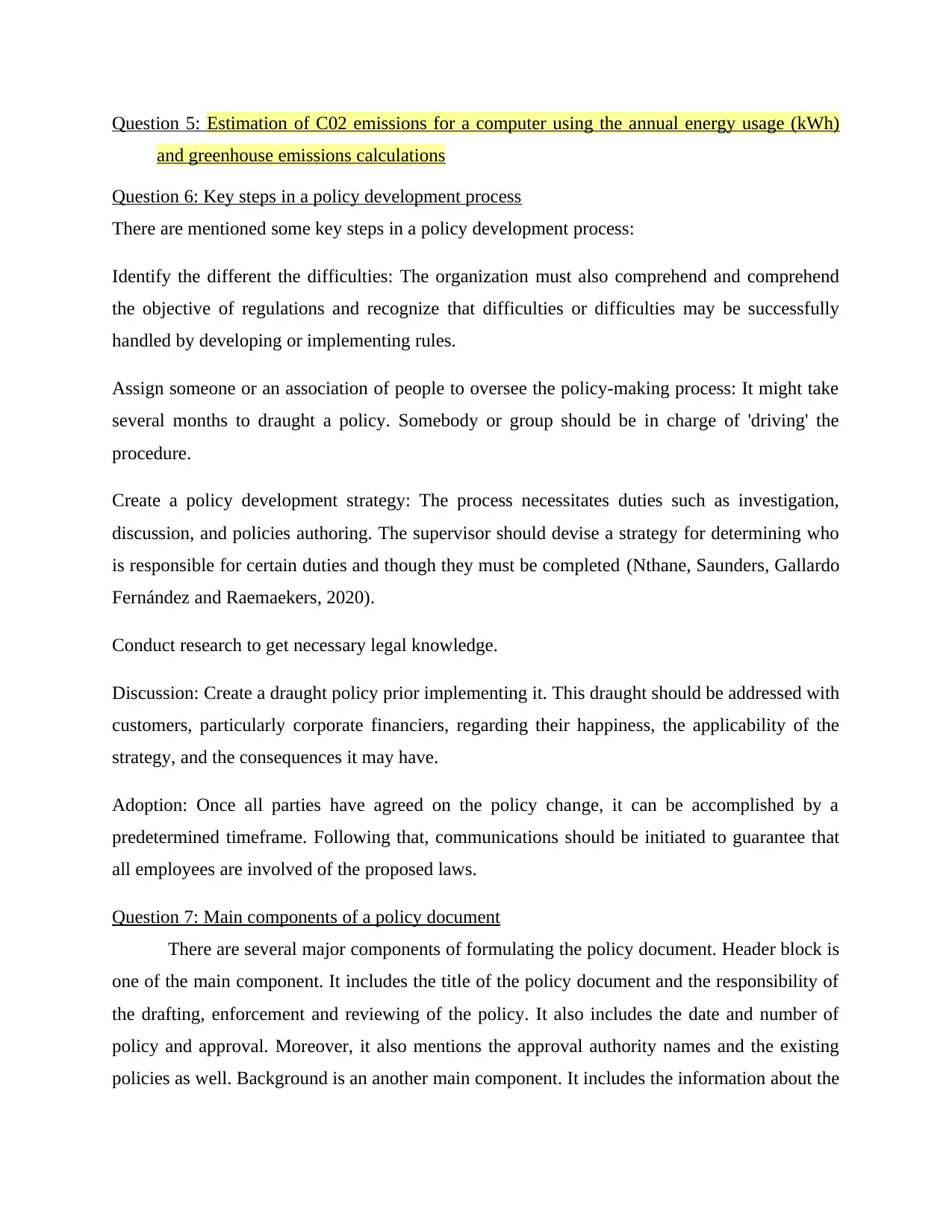
Question 5: Estimation of C02 emissions for a computer using the annual energy usage (kWh)
and greenhouse emissions calculations
Question 6: Key steps in a policy development process
There are mentioned some key steps in a policy development process:
Identify the different the difficulties: The organization must also comprehend and comprehend
the objective of regulations and recognize that difficulties or difficulties may be successfully
handled by developing or implementing rules.
Assign someone or an association of people to oversee the policy-making process: It might take
several months to draught a policy. Somebody or group should be in charge of 'driving' the
procedure.
Create a policy development strategy: The process necessitates duties such as investigation,
discussion, and policies authoring. The supervisor should devise a strategy for determining who
is responsible for certain duties and though they must be completed (Nthane, Saunders, Gallardo
Fernández and Raemaekers, 2020).
Conduct research to get necessary legal knowledge.
Discussion: Create a draught policy prior implementing it. This draught should be addressed with
customers, particularly corporate financiers, regarding their happiness, the applicability of the
strategy, and the consequences it may have.
Adoption: Once all parties have agreed on the policy change, it can be accomplished by a
predetermined timeframe. Following that, communications should be initiated to guarantee that
all employees are involved of the proposed laws.
Question 7: Main components of a policy document
There are several major components of formulating the policy document. Header block is
one of the main component. It includes the title of the policy document and the responsibility of
the drafting, enforcement and reviewing of the policy. It also includes the date and number of
policy and approval. Moreover, it also mentions the approval authority names and the existing
policies as well. Background is an another main component. It includes the information about the
and greenhouse emissions calculations
Question 6: Key steps in a policy development process
There are mentioned some key steps in a policy development process:
Identify the different the difficulties: The organization must also comprehend and comprehend
the objective of regulations and recognize that difficulties or difficulties may be successfully
handled by developing or implementing rules.
Assign someone or an association of people to oversee the policy-making process: It might take
several months to draught a policy. Somebody or group should be in charge of 'driving' the
procedure.
Create a policy development strategy: The process necessitates duties such as investigation,
discussion, and policies authoring. The supervisor should devise a strategy for determining who
is responsible for certain duties and though they must be completed (Nthane, Saunders, Gallardo
Fernández and Raemaekers, 2020).
Conduct research to get necessary legal knowledge.
Discussion: Create a draught policy prior implementing it. This draught should be addressed with
customers, particularly corporate financiers, regarding their happiness, the applicability of the
strategy, and the consequences it may have.
Adoption: Once all parties have agreed on the policy change, it can be accomplished by a
predetermined timeframe. Following that, communications should be initiated to guarantee that
all employees are involved of the proposed laws.
Question 7: Main components of a policy document
There are several major components of formulating the policy document. Header block is
one of the main component. It includes the title of the policy document and the responsibility of
the drafting, enforcement and reviewing of the policy. It also includes the date and number of
policy and approval. Moreover, it also mentions the approval authority names and the existing
policies as well. Background is an another main component. It includes the information about the
Paraphrase This Document
Need a fresh take? Get an instant paraphrase of this document with our AI Paraphraser
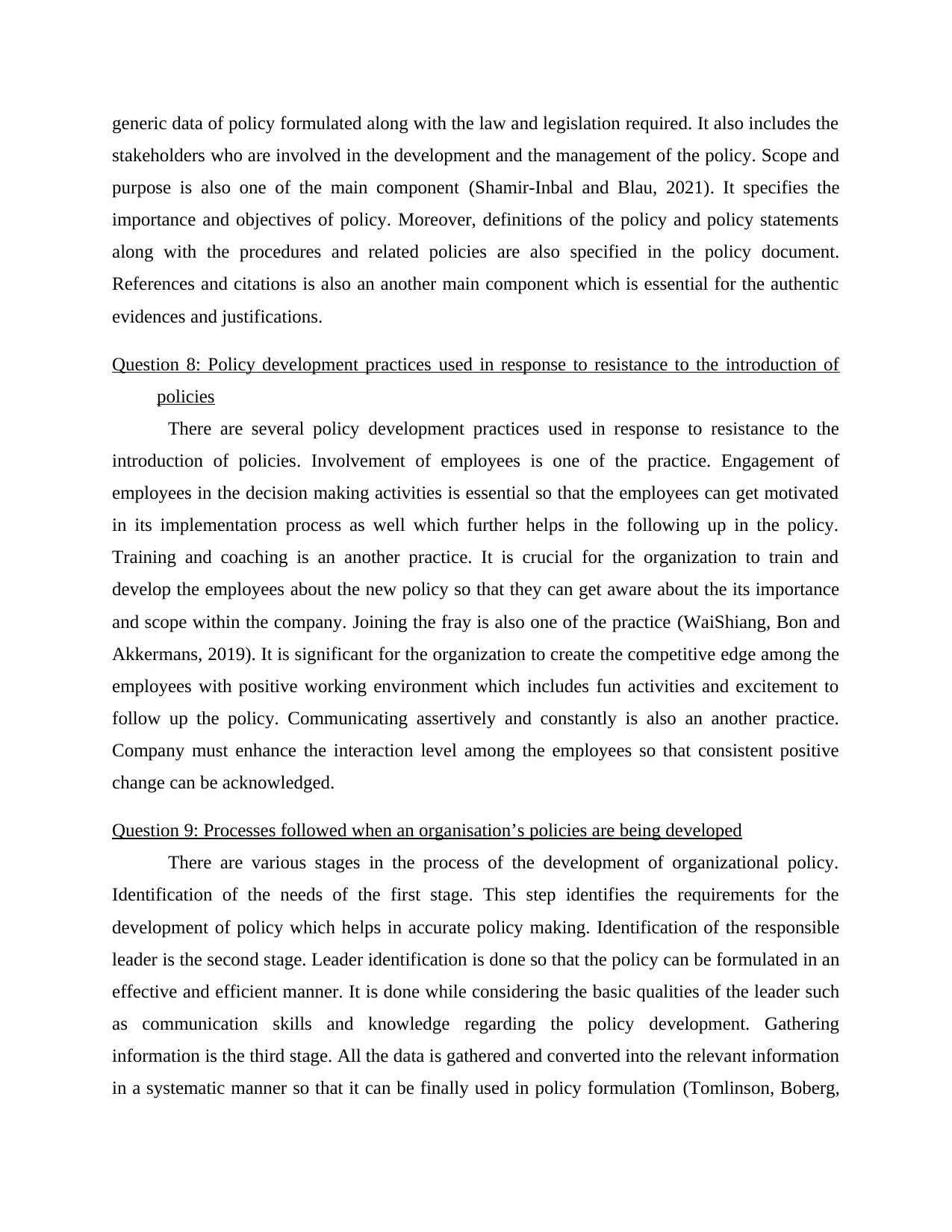
generic data of policy formulated along with the law and legislation required. It also includes the
stakeholders who are involved in the development and the management of the policy. Scope and
purpose is also one of the main component (Shamir‐Inbal and Blau, 2021). It specifies the
importance and objectives of policy. Moreover, definitions of the policy and policy statements
along with the procedures and related policies are also specified in the policy document.
References and citations is also an another main component which is essential for the authentic
evidences and justifications.
Question 8: Policy development practices used in response to resistance to the introduction of
policies
There are several policy development practices used in response to resistance to the
introduction of policies. Involvement of employees is one of the practice. Engagement of
employees in the decision making activities is essential so that the employees can get motivated
in its implementation process as well which further helps in the following up in the policy.
Training and coaching is an another practice. It is crucial for the organization to train and
develop the employees about the new policy so that they can get aware about the its importance
and scope within the company. Joining the fray is also one of the practice (WaiShiang, Bon and
Akkermans, 2019). It is significant for the organization to create the competitive edge among the
employees with positive working environment which includes fun activities and excitement to
follow up the policy. Communicating assertively and constantly is also an another practice.
Company must enhance the interaction level among the employees so that consistent positive
change can be acknowledged.
Question 9: Processes followed when an organisation’s policies are being developed
There are various stages in the process of the development of organizational policy.
Identification of the needs of the first stage. This step identifies the requirements for the
development of policy which helps in accurate policy making. Identification of the responsible
leader is the second stage. Leader identification is done so that the policy can be formulated in an
effective and efficient manner. It is done while considering the basic qualities of the leader such
as communication skills and knowledge regarding the policy development. Gathering
information is the third stage. All the data is gathered and converted into the relevant information
in a systematic manner so that it can be finally used in policy formulation (Tomlinson, Boberg,
stakeholders who are involved in the development and the management of the policy. Scope and
purpose is also one of the main component (Shamir‐Inbal and Blau, 2021). It specifies the
importance and objectives of policy. Moreover, definitions of the policy and policy statements
along with the procedures and related policies are also specified in the policy document.
References and citations is also an another main component which is essential for the authentic
evidences and justifications.
Question 8: Policy development practices used in response to resistance to the introduction of
policies
There are several policy development practices used in response to resistance to the
introduction of policies. Involvement of employees is one of the practice. Engagement of
employees in the decision making activities is essential so that the employees can get motivated
in its implementation process as well which further helps in the following up in the policy.
Training and coaching is an another practice. It is crucial for the organization to train and
develop the employees about the new policy so that they can get aware about the its importance
and scope within the company. Joining the fray is also one of the practice (WaiShiang, Bon and
Akkermans, 2019). It is significant for the organization to create the competitive edge among the
employees with positive working environment which includes fun activities and excitement to
follow up the policy. Communicating assertively and constantly is also an another practice.
Company must enhance the interaction level among the employees so that consistent positive
change can be acknowledged.
Question 9: Processes followed when an organisation’s policies are being developed
There are various stages in the process of the development of organizational policy.
Identification of the needs of the first stage. This step identifies the requirements for the
development of policy which helps in accurate policy making. Identification of the responsible
leader is the second stage. Leader identification is done so that the policy can be formulated in an
effective and efficient manner. It is done while considering the basic qualities of the leader such
as communication skills and knowledge regarding the policy development. Gathering
information is the third stage. All the data is gathered and converted into the relevant information
in a systematic manner so that it can be finally used in policy formulation (Tomlinson, Boberg,
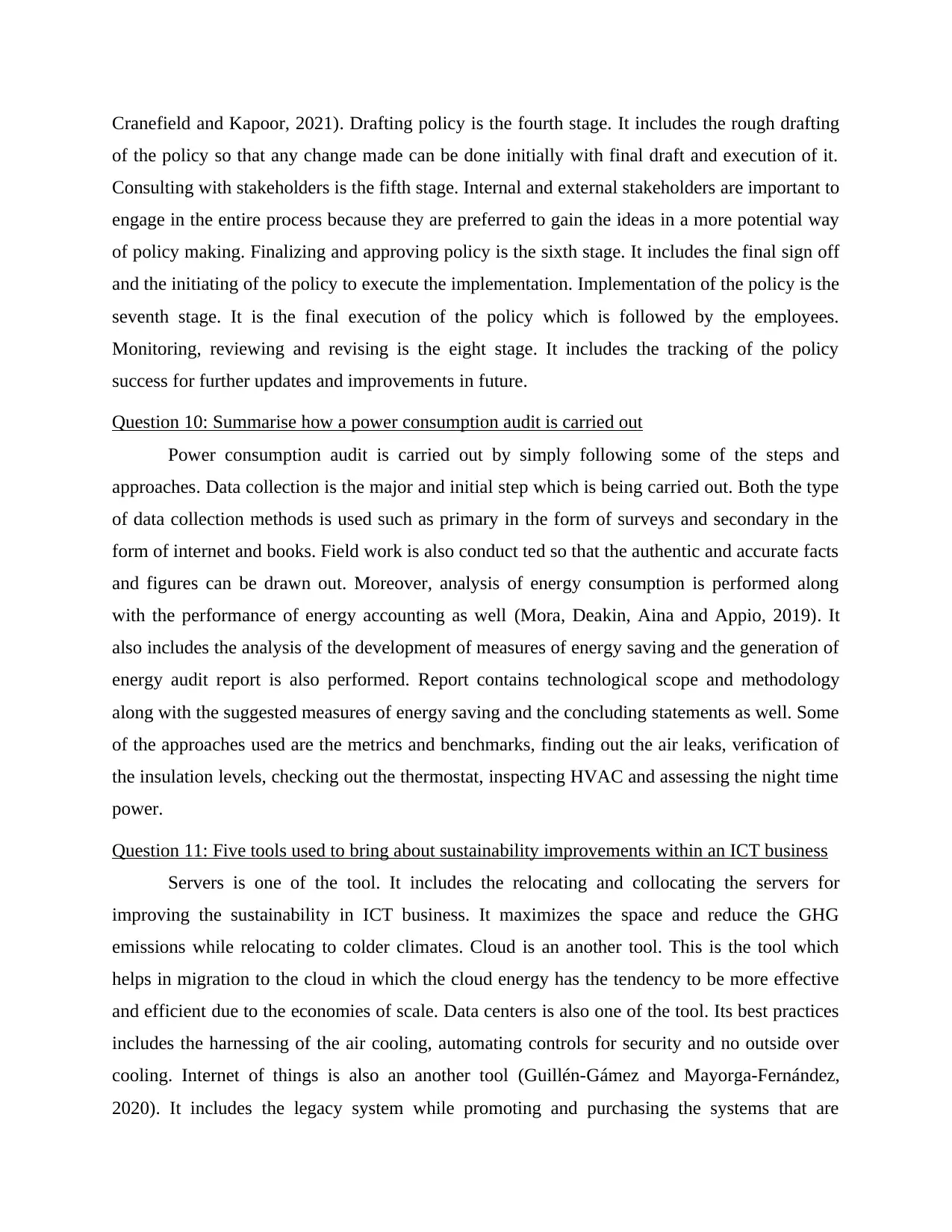
Cranefield and Kapoor, 2021). Drafting policy is the fourth stage. It includes the rough drafting
of the policy so that any change made can be done initially with final draft and execution of it.
Consulting with stakeholders is the fifth stage. Internal and external stakeholders are important to
engage in the entire process because they are preferred to gain the ideas in a more potential way
of policy making. Finalizing and approving policy is the sixth stage. It includes the final sign off
and the initiating of the policy to execute the implementation. Implementation of the policy is the
seventh stage. It is the final execution of the policy which is followed by the employees.
Monitoring, reviewing and revising is the eight stage. It includes the tracking of the policy
success for further updates and improvements in future.
Question 10: Summarise how a power consumption audit is carried out
Power consumption audit is carried out by simply following some of the steps and
approaches. Data collection is the major and initial step which is being carried out. Both the type
of data collection methods is used such as primary in the form of surveys and secondary in the
form of internet and books. Field work is also conduct ted so that the authentic and accurate facts
and figures can be drawn out. Moreover, analysis of energy consumption is performed along
with the performance of energy accounting as well (Mora, Deakin, Aina and Appio, 2019). It
also includes the analysis of the development of measures of energy saving and the generation of
energy audit report is also performed. Report contains technological scope and methodology
along with the suggested measures of energy saving and the concluding statements as well. Some
of the approaches used are the metrics and benchmarks, finding out the air leaks, verification of
the insulation levels, checking out the thermostat, inspecting HVAC and assessing the night time
power.
Question 11: Five tools used to bring about sustainability improvements within an ICT business
Servers is one of the tool. It includes the relocating and collocating the servers for
improving the sustainability in ICT business. It maximizes the space and reduce the GHG
emissions while relocating to colder climates. Cloud is an another tool. This is the tool which
helps in migration to the cloud in which the cloud energy has the tendency to be more effective
and efficient due to the economies of scale. Data centers is also one of the tool. Its best practices
includes the harnessing of the air cooling, automating controls for security and no outside over
cooling. Internet of things is also an another tool (Guillén-Gámez and Mayorga-Fernández,
2020). It includes the legacy system while promoting and purchasing the systems that are
of the policy so that any change made can be done initially with final draft and execution of it.
Consulting with stakeholders is the fifth stage. Internal and external stakeholders are important to
engage in the entire process because they are preferred to gain the ideas in a more potential way
of policy making. Finalizing and approving policy is the sixth stage. It includes the final sign off
and the initiating of the policy to execute the implementation. Implementation of the policy is the
seventh stage. It is the final execution of the policy which is followed by the employees.
Monitoring, reviewing and revising is the eight stage. It includes the tracking of the policy
success for further updates and improvements in future.
Question 10: Summarise how a power consumption audit is carried out
Power consumption audit is carried out by simply following some of the steps and
approaches. Data collection is the major and initial step which is being carried out. Both the type
of data collection methods is used such as primary in the form of surveys and secondary in the
form of internet and books. Field work is also conduct ted so that the authentic and accurate facts
and figures can be drawn out. Moreover, analysis of energy consumption is performed along
with the performance of energy accounting as well (Mora, Deakin, Aina and Appio, 2019). It
also includes the analysis of the development of measures of energy saving and the generation of
energy audit report is also performed. Report contains technological scope and methodology
along with the suggested measures of energy saving and the concluding statements as well. Some
of the approaches used are the metrics and benchmarks, finding out the air leaks, verification of
the insulation levels, checking out the thermostat, inspecting HVAC and assessing the night time
power.
Question 11: Five tools used to bring about sustainability improvements within an ICT business
Servers is one of the tool. It includes the relocating and collocating the servers for
improving the sustainability in ICT business. It maximizes the space and reduce the GHG
emissions while relocating to colder climates. Cloud is an another tool. This is the tool which
helps in migration to the cloud in which the cloud energy has the tendency to be more effective
and efficient due to the economies of scale. Data centers is also one of the tool. Its best practices
includes the harnessing of the air cooling, automating controls for security and no outside over
cooling. Internet of things is also an another tool (Guillén-Gámez and Mayorga-Fernández,
2020). It includes the legacy system while promoting and purchasing the systems that are
⊘ This is a preview!⊘
Do you want full access?
Subscribe today to unlock all pages.

Trusted by 1+ million students worldwide
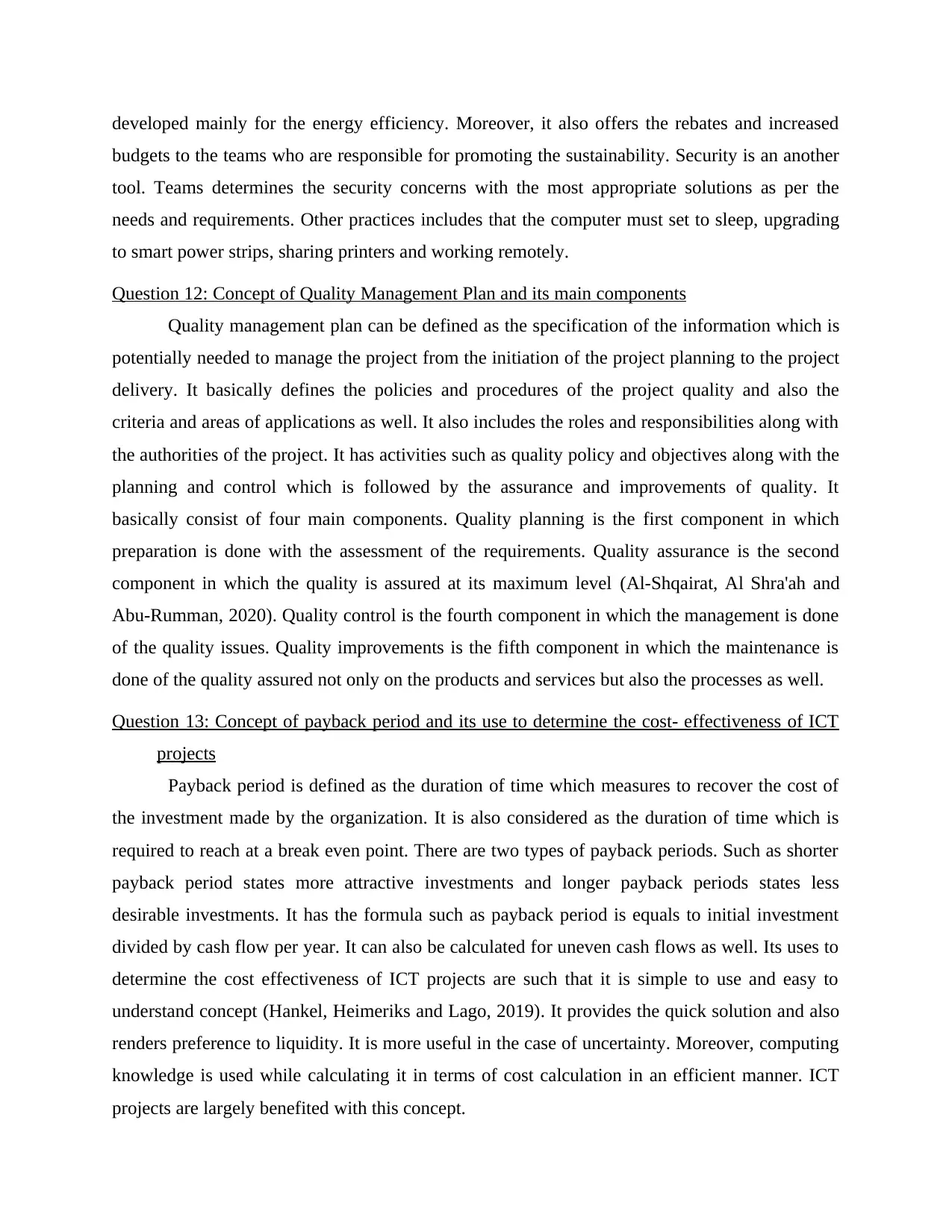
developed mainly for the energy efficiency. Moreover, it also offers the rebates and increased
budgets to the teams who are responsible for promoting the sustainability. Security is an another
tool. Teams determines the security concerns with the most appropriate solutions as per the
needs and requirements. Other practices includes that the computer must set to sleep, upgrading
to smart power strips, sharing printers and working remotely.
Question 12: Concept of Quality Management Plan and its main components
Quality management plan can be defined as the specification of the information which is
potentially needed to manage the project from the initiation of the project planning to the project
delivery. It basically defines the policies and procedures of the project quality and also the
criteria and areas of applications as well. It also includes the roles and responsibilities along with
the authorities of the project. It has activities such as quality policy and objectives along with the
planning and control which is followed by the assurance and improvements of quality. It
basically consist of four main components. Quality planning is the first component in which
preparation is done with the assessment of the requirements. Quality assurance is the second
component in which the quality is assured at its maximum level (Al-Shqairat, Al Shra'ah and
Abu-Rumman, 2020). Quality control is the fourth component in which the management is done
of the quality issues. Quality improvements is the fifth component in which the maintenance is
done of the quality assured not only on the products and services but also the processes as well.
Question 13: Concept of payback period and its use to determine the cost- effectiveness of ICT
projects
Payback period is defined as the duration of time which measures to recover the cost of
the investment made by the organization. It is also considered as the duration of time which is
required to reach at a break even point. There are two types of payback periods. Such as shorter
payback period states more attractive investments and longer payback periods states less
desirable investments. It has the formula such as payback period is equals to initial investment
divided by cash flow per year. It can also be calculated for uneven cash flows as well. Its uses to
determine the cost effectiveness of ICT projects are such that it is simple to use and easy to
understand concept (Hankel, Heimeriks and Lago, 2019). It provides the quick solution and also
renders preference to liquidity. It is more useful in the case of uncertainty. Moreover, computing
knowledge is used while calculating it in terms of cost calculation in an efficient manner. ICT
projects are largely benefited with this concept.
budgets to the teams who are responsible for promoting the sustainability. Security is an another
tool. Teams determines the security concerns with the most appropriate solutions as per the
needs and requirements. Other practices includes that the computer must set to sleep, upgrading
to smart power strips, sharing printers and working remotely.
Question 12: Concept of Quality Management Plan and its main components
Quality management plan can be defined as the specification of the information which is
potentially needed to manage the project from the initiation of the project planning to the project
delivery. It basically defines the policies and procedures of the project quality and also the
criteria and areas of applications as well. It also includes the roles and responsibilities along with
the authorities of the project. It has activities such as quality policy and objectives along with the
planning and control which is followed by the assurance and improvements of quality. It
basically consist of four main components. Quality planning is the first component in which
preparation is done with the assessment of the requirements. Quality assurance is the second
component in which the quality is assured at its maximum level (Al-Shqairat, Al Shra'ah and
Abu-Rumman, 2020). Quality control is the fourth component in which the management is done
of the quality issues. Quality improvements is the fifth component in which the maintenance is
done of the quality assured not only on the products and services but also the processes as well.
Question 13: Concept of payback period and its use to determine the cost- effectiveness of ICT
projects
Payback period is defined as the duration of time which measures to recover the cost of
the investment made by the organization. It is also considered as the duration of time which is
required to reach at a break even point. There are two types of payback periods. Such as shorter
payback period states more attractive investments and longer payback periods states less
desirable investments. It has the formula such as payback period is equals to initial investment
divided by cash flow per year. It can also be calculated for uneven cash flows as well. Its uses to
determine the cost effectiveness of ICT projects are such that it is simple to use and easy to
understand concept (Hankel, Heimeriks and Lago, 2019). It provides the quick solution and also
renders preference to liquidity. It is more useful in the case of uncertainty. Moreover, computing
knowledge is used while calculating it in terms of cost calculation in an efficient manner. ICT
projects are largely benefited with this concept.
Paraphrase This Document
Need a fresh take? Get an instant paraphrase of this document with our AI Paraphraser
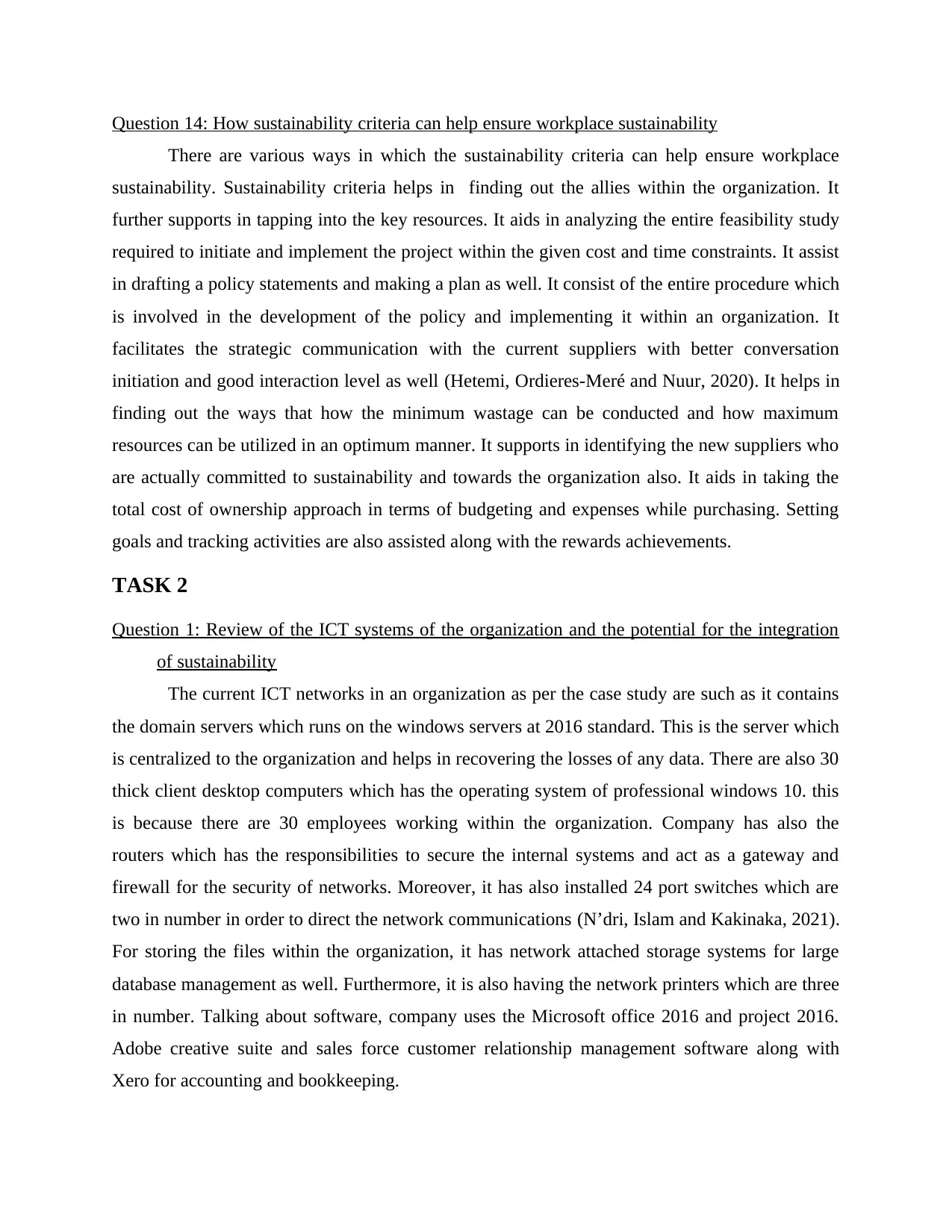
Question 14: How sustainability criteria can help ensure workplace sustainability
There are various ways in which the sustainability criteria can help ensure workplace
sustainability. Sustainability criteria helps in finding out the allies within the organization. It
further supports in tapping into the key resources. It aids in analyzing the entire feasibility study
required to initiate and implement the project within the given cost and time constraints. It assist
in drafting a policy statements and making a plan as well. It consist of the entire procedure which
is involved in the development of the policy and implementing it within an organization. It
facilitates the strategic communication with the current suppliers with better conversation
initiation and good interaction level as well (Hetemi, Ordieres-Meré and Nuur, 2020). It helps in
finding out the ways that how the minimum wastage can be conducted and how maximum
resources can be utilized in an optimum manner. It supports in identifying the new suppliers who
are actually committed to sustainability and towards the organization also. It aids in taking the
total cost of ownership approach in terms of budgeting and expenses while purchasing. Setting
goals and tracking activities are also assisted along with the rewards achievements.
TASK 2
Question 1: Review of the ICT systems of the organization and the potential for the integration
of sustainability
The current ICT networks in an organization as per the case study are such as it contains
the domain servers which runs on the windows servers at 2016 standard. This is the server which
is centralized to the organization and helps in recovering the losses of any data. There are also 30
thick client desktop computers which has the operating system of professional windows 10. this
is because there are 30 employees working within the organization. Company has also the
routers which has the responsibilities to secure the internal systems and act as a gateway and
firewall for the security of networks. Moreover, it has also installed 24 port switches which are
two in number in order to direct the network communications (N’dri, Islam and Kakinaka, 2021).
For storing the files within the organization, it has network attached storage systems for large
database management as well. Furthermore, it is also having the network printers which are three
in number. Talking about software, company uses the Microsoft office 2016 and project 2016.
Adobe creative suite and sales force customer relationship management software along with
Xero for accounting and bookkeeping.
There are various ways in which the sustainability criteria can help ensure workplace
sustainability. Sustainability criteria helps in finding out the allies within the organization. It
further supports in tapping into the key resources. It aids in analyzing the entire feasibility study
required to initiate and implement the project within the given cost and time constraints. It assist
in drafting a policy statements and making a plan as well. It consist of the entire procedure which
is involved in the development of the policy and implementing it within an organization. It
facilitates the strategic communication with the current suppliers with better conversation
initiation and good interaction level as well (Hetemi, Ordieres-Meré and Nuur, 2020). It helps in
finding out the ways that how the minimum wastage can be conducted and how maximum
resources can be utilized in an optimum manner. It supports in identifying the new suppliers who
are actually committed to sustainability and towards the organization also. It aids in taking the
total cost of ownership approach in terms of budgeting and expenses while purchasing. Setting
goals and tracking activities are also assisted along with the rewards achievements.
TASK 2
Question 1: Review of the ICT systems of the organization and the potential for the integration
of sustainability
The current ICT networks in an organization as per the case study are such as it contains
the domain servers which runs on the windows servers at 2016 standard. This is the server which
is centralized to the organization and helps in recovering the losses of any data. There are also 30
thick client desktop computers which has the operating system of professional windows 10. this
is because there are 30 employees working within the organization. Company has also the
routers which has the responsibilities to secure the internal systems and act as a gateway and
firewall for the security of networks. Moreover, it has also installed 24 port switches which are
two in number in order to direct the network communications (N’dri, Islam and Kakinaka, 2021).
For storing the files within the organization, it has network attached storage systems for large
database management as well. Furthermore, it is also having the network printers which are three
in number. Talking about software, company uses the Microsoft office 2016 and project 2016.
Adobe creative suite and sales force customer relationship management software along with
Xero for accounting and bookkeeping.
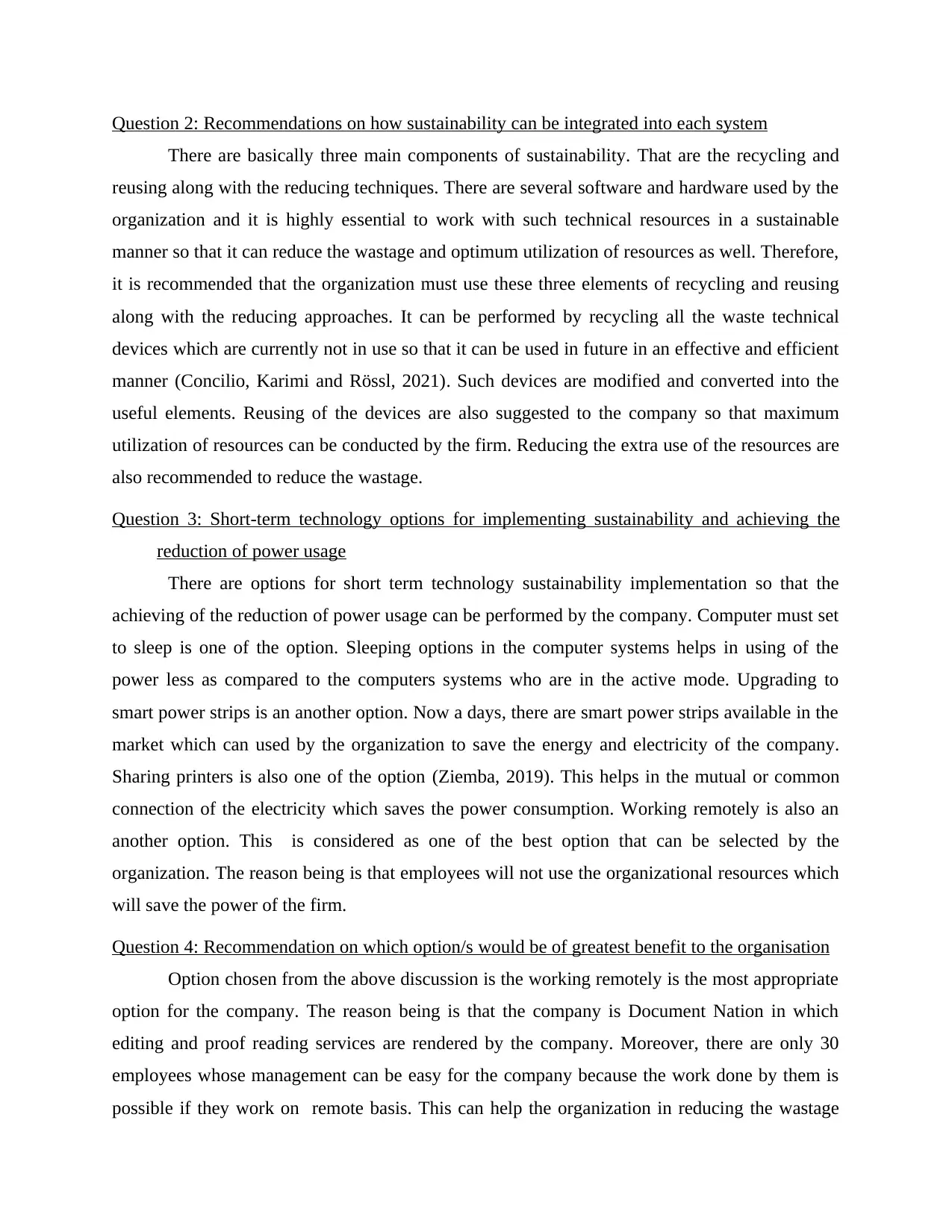
Question 2: Recommendations on how sustainability can be integrated into each system
There are basically three main components of sustainability. That are the recycling and
reusing along with the reducing techniques. There are several software and hardware used by the
organization and it is highly essential to work with such technical resources in a sustainable
manner so that it can reduce the wastage and optimum utilization of resources as well. Therefore,
it is recommended that the organization must use these three elements of recycling and reusing
along with the reducing approaches. It can be performed by recycling all the waste technical
devices which are currently not in use so that it can be used in future in an effective and efficient
manner (Concilio, Karimi and Rössl, 2021). Such devices are modified and converted into the
useful elements. Reusing of the devices are also suggested to the company so that maximum
utilization of resources can be conducted by the firm. Reducing the extra use of the resources are
also recommended to reduce the wastage.
Question 3: Short-term technology options for implementing sustainability and achieving the
reduction of power usage
There are options for short term technology sustainability implementation so that the
achieving of the reduction of power usage can be performed by the company. Computer must set
to sleep is one of the option. Sleeping options in the computer systems helps in using of the
power less as compared to the computers systems who are in the active mode. Upgrading to
smart power strips is an another option. Now a days, there are smart power strips available in the
market which can used by the organization to save the energy and electricity of the company.
Sharing printers is also one of the option (Ziemba, 2019). This helps in the mutual or common
connection of the electricity which saves the power consumption. Working remotely is also an
another option. This is considered as one of the best option that can be selected by the
organization. The reason being is that employees will not use the organizational resources which
will save the power of the firm.
Question 4: Recommendation on which option/s would be of greatest benefit to the organisation
Option chosen from the above discussion is the working remotely is the most appropriate
option for the company. The reason being is that the company is Document Nation in which
editing and proof reading services are rendered by the company. Moreover, there are only 30
employees whose management can be easy for the company because the work done by them is
possible if they work on remote basis. This can help the organization in reducing the wastage
There are basically three main components of sustainability. That are the recycling and
reusing along with the reducing techniques. There are several software and hardware used by the
organization and it is highly essential to work with such technical resources in a sustainable
manner so that it can reduce the wastage and optimum utilization of resources as well. Therefore,
it is recommended that the organization must use these three elements of recycling and reusing
along with the reducing approaches. It can be performed by recycling all the waste technical
devices which are currently not in use so that it can be used in future in an effective and efficient
manner (Concilio, Karimi and Rössl, 2021). Such devices are modified and converted into the
useful elements. Reusing of the devices are also suggested to the company so that maximum
utilization of resources can be conducted by the firm. Reducing the extra use of the resources are
also recommended to reduce the wastage.
Question 3: Short-term technology options for implementing sustainability and achieving the
reduction of power usage
There are options for short term technology sustainability implementation so that the
achieving of the reduction of power usage can be performed by the company. Computer must set
to sleep is one of the option. Sleeping options in the computer systems helps in using of the
power less as compared to the computers systems who are in the active mode. Upgrading to
smart power strips is an another option. Now a days, there are smart power strips available in the
market which can used by the organization to save the energy and electricity of the company.
Sharing printers is also one of the option (Ziemba, 2019). This helps in the mutual or common
connection of the electricity which saves the power consumption. Working remotely is also an
another option. This is considered as one of the best option that can be selected by the
organization. The reason being is that employees will not use the organizational resources which
will save the power of the firm.
Question 4: Recommendation on which option/s would be of greatest benefit to the organisation
Option chosen from the above discussion is the working remotely is the most appropriate
option for the company. The reason being is that the company is Document Nation in which
editing and proof reading services are rendered by the company. Moreover, there are only 30
employees whose management can be easy for the company because the work done by them is
possible if they work on remote basis. This can help the organization in reducing the wastage
⊘ This is a preview!⊘
Do you want full access?
Subscribe today to unlock all pages.

Trusted by 1+ million students worldwide
1 out of 17
Related Documents
Your All-in-One AI-Powered Toolkit for Academic Success.
+13062052269
info@desklib.com
Available 24*7 on WhatsApp / Email
![[object Object]](/_next/static/media/star-bottom.7253800d.svg)
Unlock your academic potential
Copyright © 2020–2025 A2Z Services. All Rights Reserved. Developed and managed by ZUCOL.





